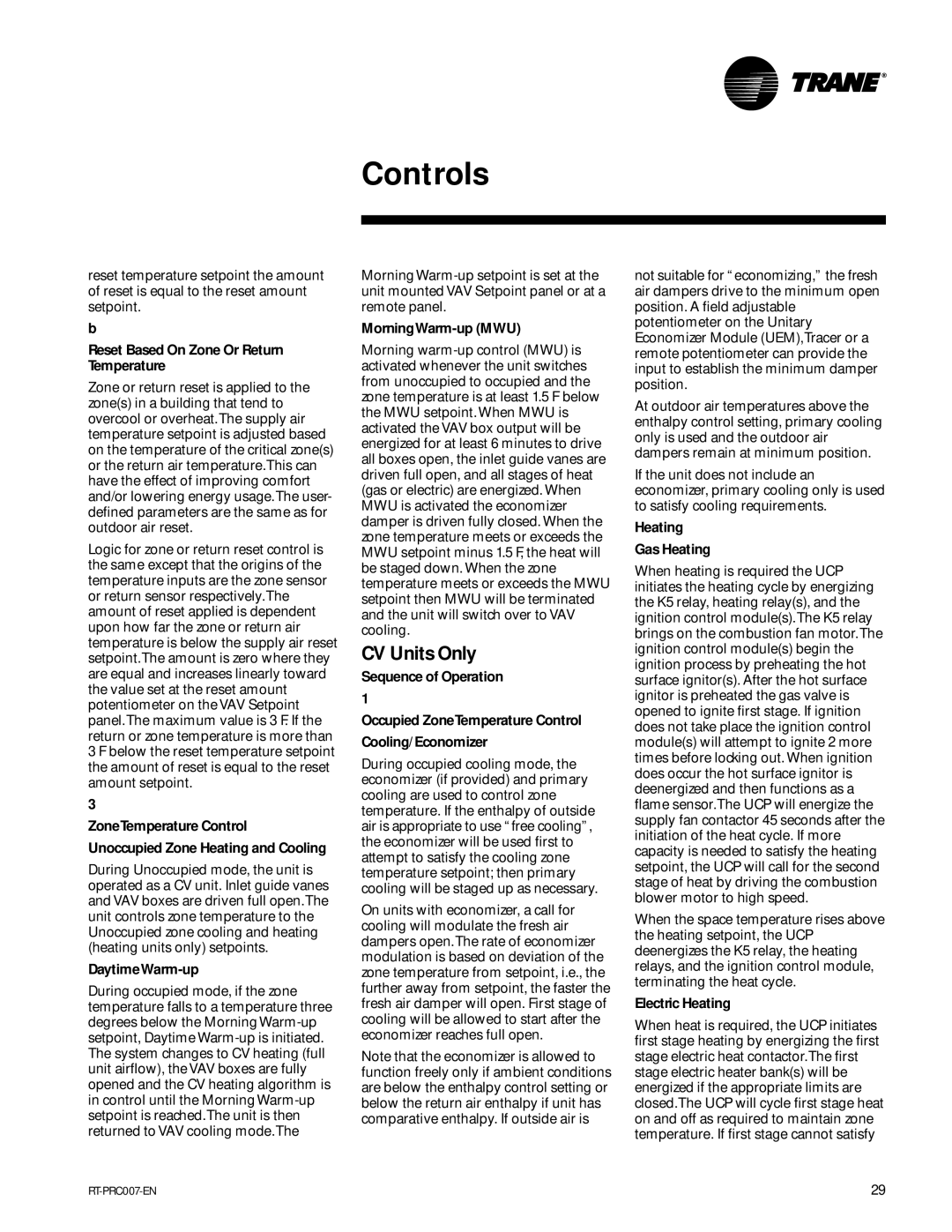reset temperature setpoint the amount of reset is equal to the reset amount setpoint.
b
Reset Based On Zone Or Return Temperature
Zone or return reset is applied to the zone(s) in a building that tend to overcool or overheat.The supply air temperature setpoint is adjusted based on the temperature of the critical zone(s) or the return air temperature.This can have the effect of improving comfort and/or lowering energy usage.The user- defined parameters are the same as for outdoor air reset.
Logic for zone or return reset control is the same except that the origins of the temperature inputs are the zone sensor or return sensor respectively.The amount of reset applied is dependent upon how far the zone or return air temperature is below the supply air reset setpoint.The amount is zero where they are equal and increases linearly toward the value set at the reset amount potentiometer on theVAV Setpoint panel.The maximum value is 3 F. If the return or zone temperature is more than 3 F below the reset temperature setpoint the amount of reset is equal to the reset amount setpoint.
3
ZoneTemperature Control
Unoccupied Zone Heating and Cooling
During Unoccupied mode, the unit is operated as a CV unit. Inlet guide vanes andVAV boxes are driven full open.The unit controls zone temperature to the Unoccupied zone cooling and heating (heating units only) setpoints.
DaytimeWarm-up
During occupied mode, if the zone temperature falls to a temperature three degrees below the MorningWarm-up setpoint, Daytime Warm-up is initiated. The system changes to CV heating (full unit airflow), theVAV boxes are fully opened and the CV heating algorithm is in control until the Morning Warm-up setpoint is reached.The unit is then returned to VAV cooling mode.The
MorningWarm-up setpoint is set at the unit mountedVAV Setpoint panel or at a remote panel.
MorningWarm-up (MWU)
Morning warm-up control (MWU) is activated whenever the unit switches from unoccupied to occupied and the zone temperature is at least 1.5 F below the MWU setpoint.When MWU is activated the VAV box output will be energized for at least 6 minutes to drive all boxes open, the inlet guide vanes are driven full open, and all stages of heat (gas or electric) are energized. When MWU is activated the economizer damper is driven fully closed. When the zone temperature meets or exceeds the MWU setpoint minus 1.5 F, the heat will be staged down. When the zone temperature meets or exceeds the MWU setpoint then MWU will be terminated and the unit will switch over to VAV cooling.
CV Units Only
Sequence of Operation
1
Occupied ZoneTemperature Control
Cooling/Economizer
During occupied cooling mode, the economizer (if provided) and primary cooling are used to control zone temperature. If the enthalpy of outside air is appropriate to use “free cooling”, the economizer will be used first to attempt to satisfy the cooling zone temperature setpoint; then primary cooling will be staged up as necessary.
On units with economizer, a call for cooling will modulate the fresh air dampers open.The rate of economizer modulation is based on deviation of the zone temperature from setpoint, i.e., the further away from setpoint, the faster the fresh air damper will open. First stage of cooling will be allowed to start after the economizer reaches full open.
Note that the economizer is allowed to function freely only if ambient conditions are below the enthalpy control setting or below the return air enthalpy if unit has comparative enthalpy. If outside air is
not suitable for “economizing,” the fresh air dampers drive to the minimum open position. A field adjustable potentiometer on the Unitary Economizer Module (UEM),Tracer or a remote potentiometer can provide the input to establish the minimum damper position.
At outdoor air temperatures above the enthalpy control setting, primary cooling only is used and the outdoor air dampers remain at minimum position.
If the unit does not include an economizer, primary cooling only is used to satisfy cooling requirements.
Heating
Gas Heating
When heating is required the UCP initiates the heating cycle by energizing the K5 relay, heating relay(s), and the ignition control module(s).The K5 relay brings on the combustion fan motor.The ignition control module(s) begin the ignition process by preheating the hot surface ignitor(s). After the hot surface ignitor is preheated the gas valve is opened to ignite first stage. If ignition does not take place the ignition control module(s) will attempt to ignite 2 more times before locking out. When ignition does occur the hot surface ignitor is deenergized and then functions as a flame sensor.The UCP will energize the supply fan contactor 45 seconds after the initiation of the heat cycle. If more capacity is needed to satisfy the heating setpoint, the UCP will call for the second stage of heat by driving the combustion blower motor to high speed.
When the space temperature rises above the heating setpoint, the UCP deenergizes the K5 relay, the heating relays, and the ignition control module, terminating the heat cycle.
Electric Heating
When heat is required, the UCP initiates first stage heating by energizing the first stage electric heat contactor.The first stage electric heater bank(s) will be energized if the appropriate limits are closed.The UCP will cycle first stage heat on and off as required to maintain zone temperature. If first stage cannot satisfy

